sensor HYUNDAI PALISADE 2022 Repair Manual
[x] Cancel search | Manufacturer: HYUNDAI, Model Year: 2022, Model line: PALISADE, Model: HYUNDAI PALISADE 2022Pages: 663, PDF Size: 15.74 MB
Page 477 of 663
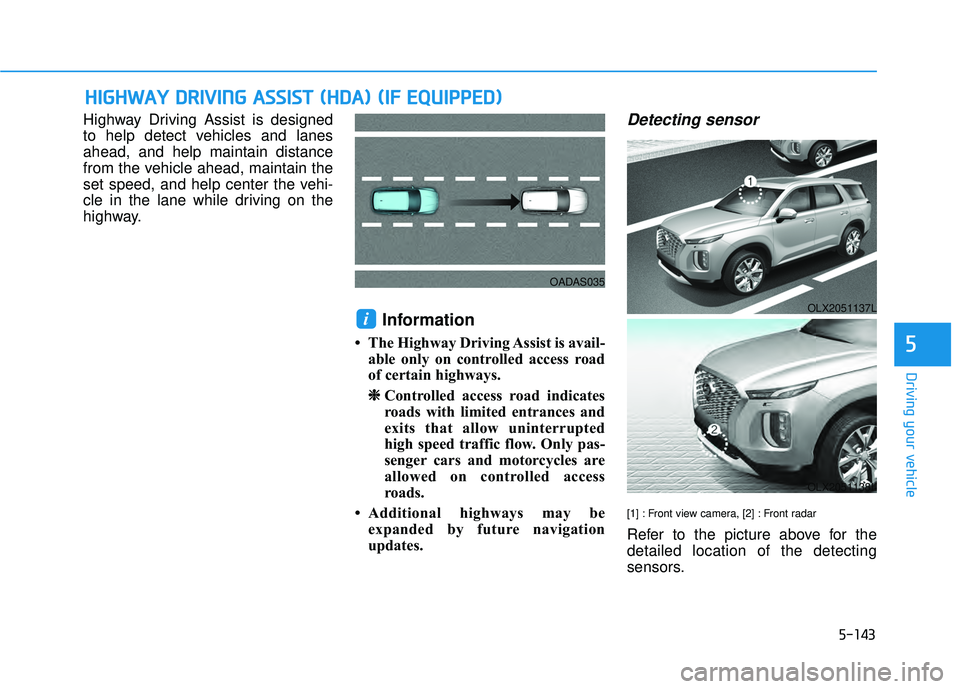
5-143
Driving your vehicle
Highway Driving Assist is designed
to help detect vehicles and lanes
ahead, and help maintain distance
from the vehicle ahead, maintain the
set speed, and help center the vehi-
cle in the lane while driving on the
highway.
Information
• The Highway Driving Assist is avail-able only on controlled access road
of certain highways.
❈ ❈ Controlled access road indicates
roads with limited entrances and
exits that allow uninterrupted
high speed traffic flow. Only pas-
senger cars and motorcycles are
allowed on controlled access
roads.
• Additional highways may be expanded by future navigation
updates.
Detecting sensor
[1] : Front view camera, [2] : Front radar
Refer to the picture above for the
detailed location of the detecting
sensors.
i
H HI IG G H H W W A AY Y D D R RI IV V I IN N G G A A S SS SI IS S T T ( ( H H D DA A ) ) ( ( I IF F E E Q Q U UI IP P P PE ED D ) )
5
OADAS035
OLX2051137L
OLX2051138L
Page 478 of 663

5-144
Highway Driving Assist
Settings
Setting features
Highway Driving Assist
With the engine on, select or dese-
lect ‘Driver Assistance →Driving
Convenience’ from the Settings
menu to set whether or not to use the
following function(s).
- If ‘Highway Driving Assist’ is select- ed, it helps maintain distance from
the vehicle ahead, maintain the set
speed, and helps center the vehicle
in the lane.
Information
• If there is a problem with the func- tion(s), the settings cannot be
changed. We recommend that the
vehicle be inspected by an author-
ized HYUNDAI dealer.
• If the engine is restarted, the func- tion(s) will maintain the last setting.
i
Driving your vehicle
For more details on the precau-
tions of the detecting sensors,
refer to “Forward Collision-
Avoidance Assist (FCA)” sec-
tion in chapter 5.
CAUTION
OLX2071066N
Page 483 of 663

5-149
Driving your vehicle
Limitations of Highway DrivingAssist
Highway Driving Assist may not
operate normally, or may not operate
under the following circumstances:
The map information and the actu-
al road is different because the
navigation is not updated
The map information and the actu- al road is different because of real-
time GPS data or map information
error
The infotainment system is over- loaded by simultaneously perform-
ing functions such as route search,
video playback, voice recognition,
etc.
GPS signals are blocked in areas such as a tunnel
The driver goes off course or the route to the destination is changed
or canceled by resetting the navi-
gation
The vehicle enters a service sta- tion or rest area
Android Auto or Car Play is operat- ing
5
Highway Driving Assist may
inadvertently operate or turn
off depending on road condi-
tions (navigation information)
and surroundings.
Lane Following Assist func-
tion may be temporarily dis-
abled when the front view
camera cannot detect lanes
properly or the hands-off
warning is on.
You may not hear the warning
sound of Highway Driving
Assist if the surrounding is
noisy.
If the vehicle is driven at high
speed above a certain speed
at a curve, your vehicle may
drive to one side or may
depart from the driving lane.
When you are towing a trailer
or another vehicle, we recom-
mend that Highway Driving
Assist is turned off due to
safety reasons.The hands–off warning mes-
sage may appear early or late
depending on how the steer-
ing wheel is held or road con-
ditions. Always have your
hands on the steering wheel
while driving.
For your safety, please read
the owner's manual before
using the Highway Driving
Assist.
Highway Driving Assist will
not operate when the engine
is started, or when the detect-
ing sensors or navigation is
being initialized.
Page 485 of 663

5-151
Driving your vehicle
5
S SM M A AR RT T C C R R U U I IS S E E C C O O N NT TR R O O L L ( ( S S C C C C) ) ( ( I IF F E E Q Q U UI IP P P PE ED D ) )
Smart Cruise Control is designed to
detect the vehicle ahead and help
maintain the desired speed and min-
imum distance between the vehicle
ahead.
Overtaking Acceleration Assist
While Smart Cruise Control is oper-
ating, if the function judges that the
driver is determined to overtake the
vehicle in front, acceleration will be
assisted.
[1]: Front view camera, [2]: Front radar
The front view camera and front
radar are used as a detecting sensor
to detect front vehicles.
Refer to the picture above for the
detailed location of the detecting
sensor.
OLX2051137L
OLX2051138L
Always keep the front view cam-
era and front radar in good con-
dition to maintain optimal per-
formance of Smart Cruise
Control.
For more details on the precau-
tions of the front view camera
and front radar, refer to
“Forward Collision-Avoidance
Assist (FCA)” section in this
chapter.
CAUTION
Page 497 of 663
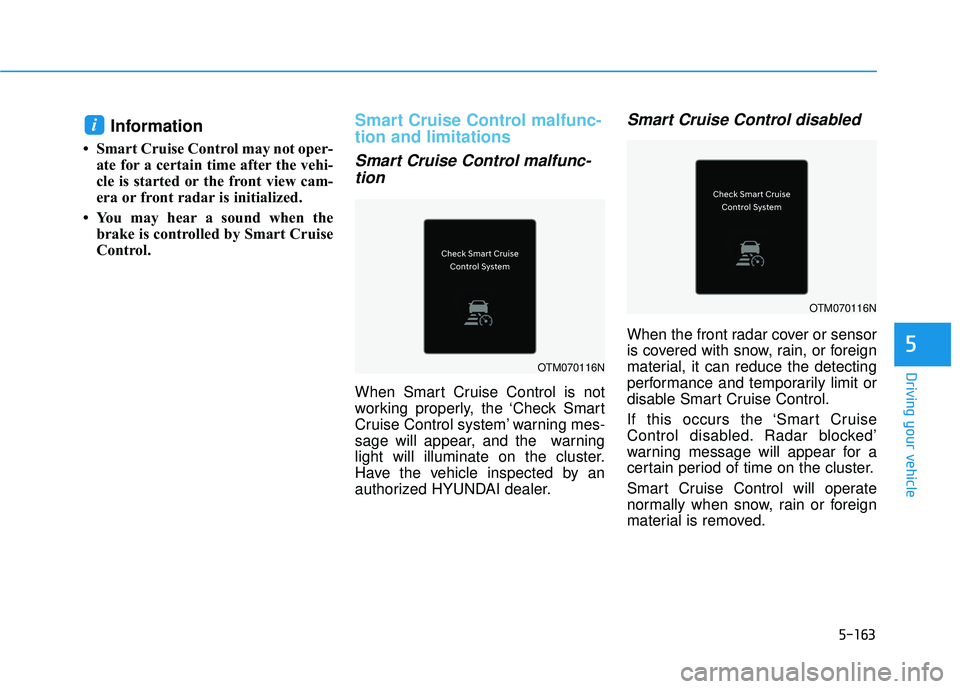
5-163
Driving your vehicle
5
Information
• Smart Cruise Control may not oper-ate for a certain time after the vehi-
cle is started or the front view cam-
era or front radar is initialized.
• You may hear a sound when the brake is controlled by Smart Cruise
Control.
Smart Cruise Control malfunc-
tion and limitations
Smart Cruise Control malfunc-tion
When Smart Cruise Control is not
working properly, the ‘Check Smart
Cruise Control system’ warning mes-
sage will appear, and the warning
light will illuminate on the cluster.
Have the vehicle inspected by an
authorized HYUNDAI dealer.
Smart Cruise Control disabled
When the front radar cover or sensor
is covered with snow, rain, or foreign
material, it can reduce the detecting
performance and temporarily limit or
disable Smart Cruise Control.
If this occurs the ‘Smart Cruise
Control disabled. Radar blocked’
warning message will appear for a
certain period of time on the cluster.
Smart Cruise Control will operate
normally when snow, rain or foreign
material is removed.
i
OTM070116N
OTM070116N
Page 498 of 663

5-164
Driving your vehicle
Limitations of Smart CruiseControl
Smart Cruise Control may not oper-
ate normally, or it may operate unex-
pectedly under the following circum-
stances:
The detecting sensor or the sur-
roundings are contaminated or
damaged
fluid is continuously sprayed, or the wiper is on
The camera lens is contaminated due to tinted, filmed or coated
windshield, damaged glass, or
sticky foreign material (sticker, bug,
etc.) on the glass
Moisture is not removed or frozen on the windshield
The field of view of the front view camera is obstructed by sun glare
Street light or light from an oncom- ing vehicle is reflected on the wet
road surface, such as a puddle on
the road
The temperature around the front view camera is high or low An object is placed on the dash-
board
The surrounding is very bright
The surrounding is very dark, such as in a tunnel, etc.
The brightness changes suddenly, for example when entering or exit-
ing a tunnel
The brightness outside is low, and the headlamps are not on or are
not bright
Driving in heavy rain or snow, or thick fog
Driving through steam, smoke or shadow
Only part of the vehicle is detected
The vehicle in front has no tail lights, tail lights are located unusu-
ally, etc.
The brightness outside is low, and the tail lamps are not on or are not
bright
The rear of the front vehicle is small or does not look normal (for
example, tilted, overturned, etc.)
The front vehicle’s ground clear- ance is low or high
Even though the warning mes-
sage does not appear on the
cluster, Smart Cruise Control
may not properly operate.
WARNING
Smart Cruise Control may not
properly operate in an area (for
example, open terrain), where
there is nothing to detect after
turning ON the engine.
CAUTION
Page 501 of 663
![HYUNDAI PALISADE 2022 Repair Manual 5-167
Driving your vehicle
5
Changing lanes
[A] : Your vehicle, [B] : Lane changing vehicle
When a vehicle moves into your
lane from an adjacent lane, it can-
not be detected by the sensor until
it i HYUNDAI PALISADE 2022 Repair Manual 5-167
Driving your vehicle
5
Changing lanes
[A] : Your vehicle, [B] : Lane changing vehicle
When a vehicle moves into your
lane from an adjacent lane, it can-
not be detected by the sensor until
it i](/img/35/41170/w960_41170-500.png)
5-167
Driving your vehicle
5
Changing lanes
[A] : Your vehicle, [B] : Lane changing vehicle
When a vehicle moves into your
lane from an adjacent lane, it can-
not be detected by the sensor until
it is in the sensor's detection range.Smart Cruise Control may not
immediately detect the vehicle
when the vehicle changes lanes
abruptly. In this case, you must
maintain a safe braking distance,
and if necessary, depress the
brake pedal to reduce your driving
speed in order to maintain a safe
distance.
Detecting vehicle
In the following cases, some vehi-
cles in your lane cannot be detect-
ed by the sensor:
- Vehicles offset to one side
- Slow-moving vehicles or sudden-decelerating vehicles
- Vehicles within approximately 6 feet (2 m) from your vehicle
- Oncoming vehicles
- Stopped vehicles
- Vehicles with small rear profile, such as trailers
- Narrow vehicles, such as motor- cycles or bicycles
- Special vehicles
OJX1070181R
OADAS030
Page 502 of 663
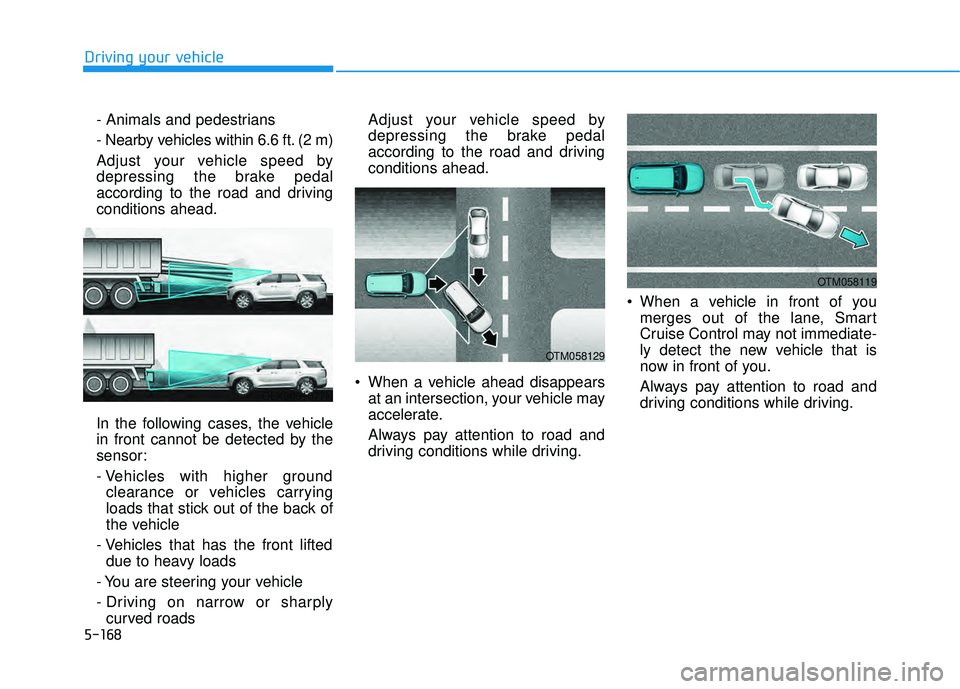
5-168
Driving your vehicle- Animals and pedestrians
- Nearby vehicles within 6.6 ft. (2 m)
Adjust your vehicle speed by
depressing the brake pedal
according to the road and driving
conditions ahead.
In the following cases, the vehicle
in front cannot be detected by the
sensor:
- Vehicles with higher groundclearance or vehicles carrying
loads that stick out of the back of
the vehicle
- Vehicles that has the front lifted due to heavy loads
- You are steering your vehicle
- Driving on narrow or sharply curved roads Adjust your vehicle speed by
depressing the brake pedal
according to the road and driving
conditions ahead.
When a vehicle ahead disappears at an intersection, your vehicle may
accelerate.
Always pay attention to road and
driving conditions while driving. When a vehicle in front of you
merges out of the lane, Smart
Cruise Control may not immediate-
ly detect the new vehicle that is
now in front of you.
Always pay attention to road and
driving conditions while driving.
OTM058129
OTM058119
OLX2051077N
Page 544 of 663
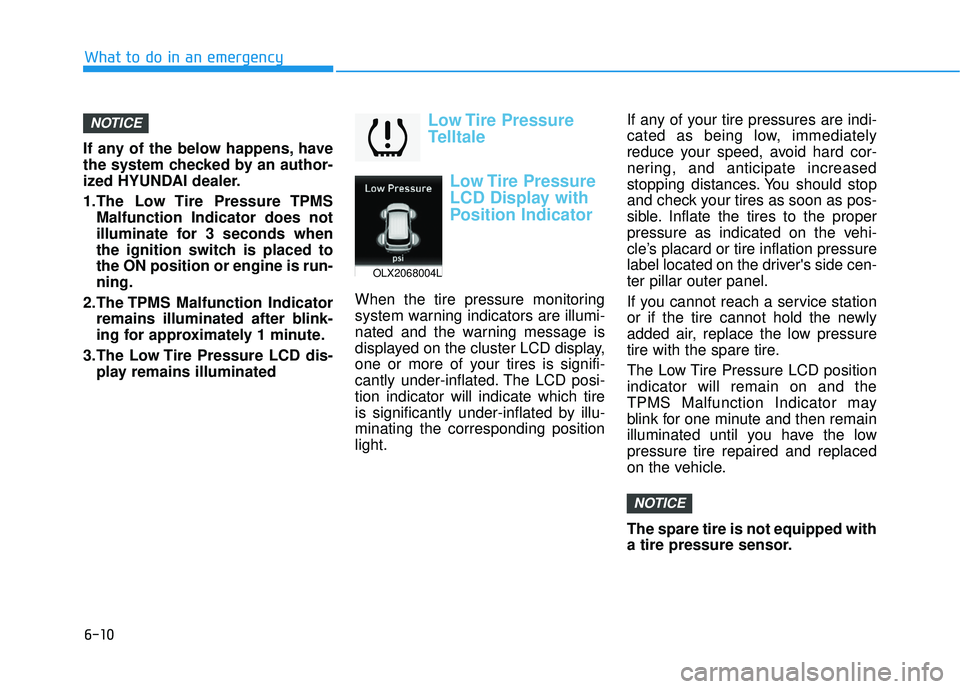
6-10
What to do in an emergency
If any of the below happens, have
the system checked by an author-
ized HYUNDAI dealer.
1.The Low Tire Pressure TPMS Malfunction Indicator does not
illuminate for 3 seconds when
the ignition switch is placed to
the ON position or engine is run-
ning.
2.The TPMS Malfunction Indicator remains illuminated after blink-
ing for approximately 1 minute.
3.The Low Tire Pressure LCD dis- play remains illuminated
Low Tire Pressure
Telltale
Low Tire Pressure
LCD Display with
Position Indicator
When the tire pressure monitoring
system warning indicators are illumi-
nated and the warning message is
displayed on the cluster LCD display,
one or more of your tires is signifi-
cantly under-inflated. The LCD posi-
tion indicator will indicate which tire
is significantly under-inflated by illu-
minating the corresponding position
light. If any of your tire pressures are indi-
cated as being low, immediately
reduce your speed, avoid hard cor-
nering, and anticipate increased
stopping distances. You should stop
and check your tires as soon as pos-
sible. Inflate the tires to the proper
pressure as indicated on the vehi-
cle’s placard or tire inflation pressure
label located on the driver's side cen-
ter pillar outer panel.
If you cannot reach a service station
or if the tire cannot hold the newly
added air, replace the low pressure
tire with the spare tire.
The Low Tire Pressure LCD position
indicator will remain on and the
TPMS Malfunction Indicator may
blink for one minute and then remain
illuminated until you have the low
pressure tire repaired and replaced
on the vehicle.
The spare tire is not equipped with
a tire pressure sensor.
NOTICE
NOTICE
OLX2068004L
Page 546 of 663
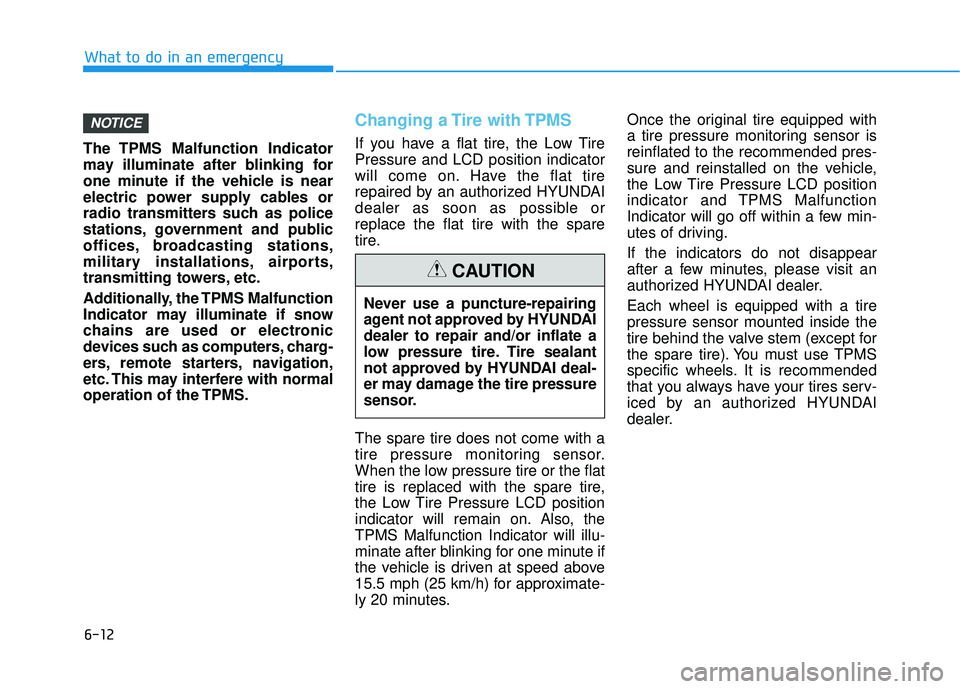
6-12
What to do in an emergency
The TPMS Malfunction Indicator
may illuminate after blinking for
one minute if the vehicle is near
electric power supply cables or
radio transmitters such as police
stations, government and public
offices, broadcasting stations,
military installations, airports,
transmitting towers, etc.
Additionally, the TPMS Malfunction
Indicator may illuminate if snow
chains are used or electronic
devices such as computers, charg-
ers, remote starters, navigation,
etc. This may interfere with normal
operation of the TPMS.
Changing a Tire with TPMS
If you have a flat tire, the Low Tire
Pressure and LCD position indicator
will come on. Have the flat tire
repaired by an authorized HYUNDAI
dealer as soon as possible or
replace the flat tire with the spare
tire.
The spare tire does not come with a
tire pressure monitoring sensor.
When the low pressure tire or the flat
tire is replaced with the spare tire,
the Low Tire Pressure LCD position
indicator will remain on. Also, the
TPMS Malfunction Indicator will illu-
minate after blinking for one minute if
the vehicle is driven at speed above
15.5 mph (25 km/h) for approximate-
ly 20 minutes. Once the original tire equipped with
a tire pressure monitoring sensor is
reinflated to the recommended pres-
sure and reinstalled on the vehicle,
the Low Tire Pressure LCD position
indicator and TPMS Malfunction
Indicator will go off within a few min-
utes of driving.
If the indicators do not disappear
after a few minutes, please visit an
authorized HYUNDAI dealer.
Each wheel is equipped with a tire
pressure sensor mounted inside the
tire behind the valve stem (except for
the spare tire). You must use TPMS
specific wheels. It is recommended
that you always have your tires serv-
iced by an authorized HYUNDAI
dealer.
NOTICE
Never use a puncture-repairing
agent not approved by HYUNDAI
dealer to repair and/or inflate a
low pressure tire. Tire sealant
not approved by HYUNDAI deal-
er may damage the tire pressure
sensor.
CAUTION